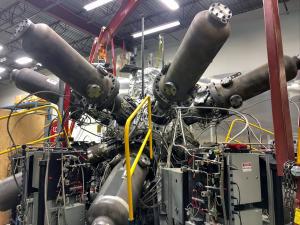"Steampunk" fusion machine travels in time
Ever since a "Mr Fusion" device appeared on Doc's time-travelling DeLorean in the first opus of the Back to the Future trilogy (1985), fusion energy has exerted a fascination on the film industry. Countless productions, from The Saint (1997) to the 2014 blockbuster Interstellar have featured fusion machines that are either central or accessory to the plot. Travelers, a Netflix series that premiered in December 2016, offers the latest example in this trend—except that an actual, real-life fusion machine plays the part of an antimatter device used to deflect an incoming asteroid.
Neither a tokamak nor a stellarator nor even a zeta-pinch, the machine developed by General Fusion, a private fusion venture on the outskirts of Vancouver, Canada, is based on an unconventional approach. It uses steam-driven pistons to compress the plasma and heat it to fusion conditions. As a result, the device has a most unusual appearance that is sometimes described as steampunk—19th century technology and aesthetics set in a futuristic context.
Having completed their experimental campaign on the "steampunk" device, the General Fusion team made their workshop available to the Travelers production. A few props were added and—for a couple of days—a team of special agents from the post-apocalyptic future engaged in shootouts, personality transfers and other transforming acts that make up the gist of the series.



